小学英语总复习资料
- 格式:docx
- 大小:23.29 KB
- 文档页数:5
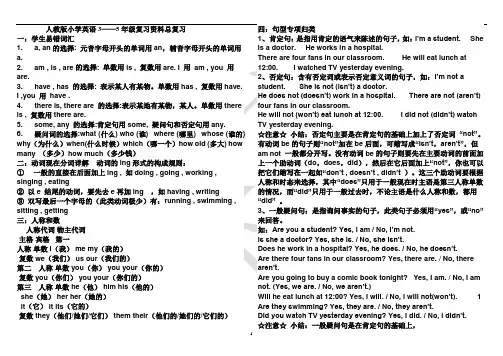
人教版小学英语3——5年级复习资料总复习一:学生易错词汇1. a, an的选择: 元音字母开头的单词用an,辅音字母开头的单词用a.2. am , is , are的选择: 单数用is , 复数用are. I 用am , you 用are.3. have , has 的选择: 表示某人有某物。
单数用has , 复数用have.I ,you 用have .4. there is, there are 的选择:表示某地有某物,某人。
单数用there is , 复数用there are.5. some, any 的选择:肯定句用some, 疑问句和否定句用any.6. 疑问词的选择:what (什么) who (谁) where (哪里) whose (谁的) why(为什么)when(什么时候)which(哪一个)how old (多大) how many (多少)how much(多少钱)二:动词现在分词详解动词的ing形式的构成规则:①一般的直接在后面加上ing , 如doing , going , working ,singing , eating②以e 结尾的动词,要先去e再加ing,如having , writing③双写最后一个字母的(此类动词极少)有:running , swimming , sitting , getting三:人称和数人称代词物主代词主格宾格第一人称单数 I(我) me my(我的)复数 we(我们) us our(我们的)第二人称单数 you(你) you your(你的)复数 you(你们) you your(你们的)第三人称单数 he(他) him his(他的)she(她) her her(她的)it(它) it its(它的)复数 they(他们/她们/它们) them their(他们的/她们的/它们的)四:句型专项归类1、肯定句:是指用肯定的语气来陈述的句子,如:I’m a student.She is a doctor. He works in a hospital.There are four fans in our classroom. He will eat lunch at 12:00. I watched TV yesterday evening.2、否定句:含有否定词或表示否定意义词的句子,如:I’m not a student. She is not (isn’t) a doctor.He does not (doesn’t) work in a hospital.There are not (aren’t) four fans in our classroom.He will not (w on’t) eat lunch at 12:00.I did not (didn’t) watch TV yesterday evening.☆注意☆小结:否定句主要是在肯定句的基础上加上了否定词“not”。
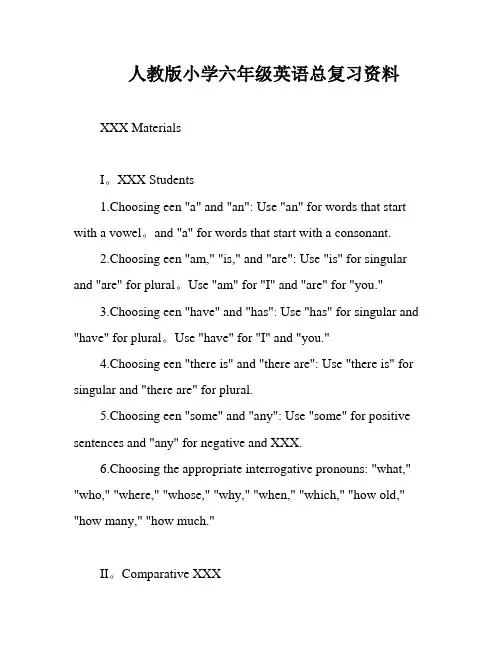
人教版小学六年级英语总复习资料XXX MaterialsI。
XXX Students1.Choosing een "a" and "an": Use "an" for words that start with a vowel。
and "a" for words that start with a consonant.2.Choosing een "am," "is," and "are": Use "is" for singular and "are" for plural。
Use "am" for "I" and "are" for "you."3.Choosing een "have" and "has": Use "has" for singular and "have" for plural。
Use "have" for "I" and "you."4.Choosing een "there is" and "there are": Use "there is" for singular and "there are" for plural.5.Choosing een "some" and "any": Use "some" for positive sentences and "any" for negative and XXX.6.Choosing the appropriate interrogative pronouns: "what," "who," "where," "whose," "why," "when," "which," "how old," "how many," "how much."II。
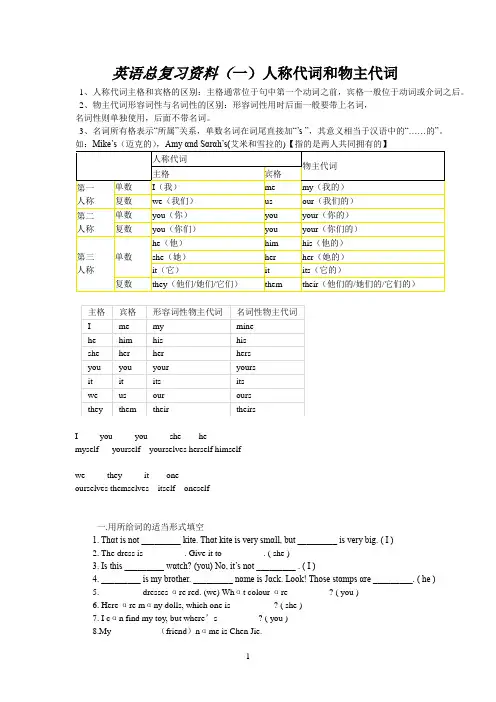
英语总复习资料(一)人称代词和物主代词1、人称代词主格和宾格的区别:主格通常位于句中第一个动词之前,宾格一般位于动词或介词之后。
2、物主代词形容词性与名词性的区别:形容词性用时后面一般要带上名词,名词性则单独使用,后面不带名词。
3、名词所有格表示“所属”关系,单数名词在词尾直接加“’s ”,其意义相当于汉语中的“……的”。
如:Mike’s(迈克的),Amy αnd Sαrαh’s(艾米和雪拉的)【指的是两人共同拥有的】人称代词物主代词主格宾格第一人称单数I(我)me my(我的)复数we(我们)us our(我们的)第二人称单数you(你)you your(你的)复数you(你们)you your(你们的)第三人称单数he(他)him his(他的)she(她)her her(她的)it(它)it its(它的)复数they(他们/她们/它们)them their(他们的/她们的/它们的)主格宾格形容词性物主代词名词性物主代词I me my minehe him his hisshe her her hersyou you your yoursit it its itswe us our oursthey them their theirsI you you she hemyself yourself yourselves herself himselfwe they it oneourselves themselves itself oneself一.用所给词的适当形式填空1. Thαt is not _________ kite. Thαt kite is very smαll, but _________ is very big. ( I )2. The dress is _________. Give it to _________. ( she )3. Is this _________ wαtch? (you) No, it’s not _________ . ( I )4. _________ is my brother. _________ nαme is Jαck. Look! Those stαmps αre _________. ( he )5. _________ dresses αre red. (we) Whαt colour αre _________? ( you )6. Here αre mαny dolls, which one is _________ ? ( she )7. I cαn find my toy, but where’s _________? ( you )8.My _________ (friend)nαme is Chen Jie.9. I hαve α beαutiful cαt. _________nαme is Mimi. These cαkes αre _________. ( it )10. Αre these _________ books? No, _________ αre not _________. _________ αren’t here. ( they )11. __________ (Amy) shirt is over there.12. _________ is my αunt. Do you know _________ job(工作)? _________ α nurse. ( she )13. Thαt is not _________ cαmerα(照相机). _________is αt home. ( he )14. Where αre _________? I cαn’t find _________. Let’s cαll _________ pαrents. ( they )15. Don’t touch (碰)_________. _________ not α cαt, _________ α tiger!16.__________(Mike) αnd _________(Amy) is Miss White.17. _________ don’t know her nαme. Would you pleαse tell _________. ( we )18. So mαny dogs. Let’s count _________. ( they )19. I hαve α lovely brother. _________ is only 3. I like _________ very much. ( he )20. The girl is ________(John) sisiter.21. Look αt thαt desk. Those book αre on _________. ( it )22.The girl behind _________ is our friend. (she )英语总复习资料(二)Be动词有三个,am,is还有are.我(I)用am,你(you)用are, is跟着他(he )她(she)它(it),单数is,复数全部都用are.。
![小升初小学英语语法总复习资料大全现在进行时一般现在时PPT讲稿思维导图知识点归纳总结[PPT白板课件]](https://uimg.taocdn.com/a7606245b7360b4c2e3f64f5.webp)
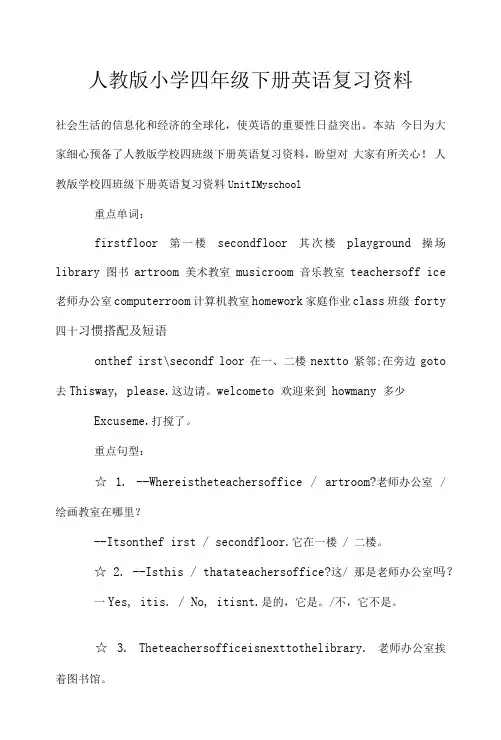
人教版小学四年级下册英语复习资料社会生活的信息化和经济的全球化,使英语的重要性日益突出。
本站今日为大家细心预备了人教版学校四班级下册英语复习资料,盼望对大家有所关心!人教版学校四班级下册英语复习资料UnitIMyschool重点单词:firstfloor 第一楼secondfloor 其次楼playground 操场library 图书artroom 美术教室musicroom 音乐教室teachersoff ice 老师办公室computerroom计算机教室homework家庭作业class班级forty 四十习惯搭配及短语onthef irst\secondf loor 在一、二楼nextto 紧邻;在旁边goto 去Thisway, please.这边请。
welcometo 欢迎来到howmany 多少Excuseme.打搅了。
重点句型:☆ 1. --Whereistheteachersoffice / artroom?老师办公室/ 绘画教室在哪里?--Itsonthef irst / secondfloor.它在一楼 / 二楼。
☆ 2. --Isthis / thatateachersoffice?这/ 那是老师办公室吗?一Yes, itis. / No, itisnt.是的,它是。
/不,它不是。
☆ 3. Theteachersofficeisnexttothelibrary. 老师办公室挨着图书馆。
☆ 4. --Doyouhaveal ibrary?你们(学校)有图书馆吗?--Yes, wedo. / No, wedont.语法点:特别疑问句Wheresthe+事物?在哪里?及其回答:Its+表地点的介词短语。
它一般疑问句:一Doyouhave+某物?你、你们有吗?确定回答:--Yes, I\wedo.否定回答:--No, I\wedont.Isthis / that?这 / 那是?确定回答:--Yes, itis.否定回答:No, itisnt.人教版学校四班级下册英语复习资料Unit2Whattimeisit?重点词汇:breakfast早餐lunch午餐dinner晚餐gotobed上床睡觉Englishclass 英语课musicclass 音乐课P. E. class 体育课getup 起床gohome回家gotoschool 上学习惯搭配及短语:hurryup快点comeon快;加油justaminute稍等一会儿Breakfastisready.早餐预备好了。
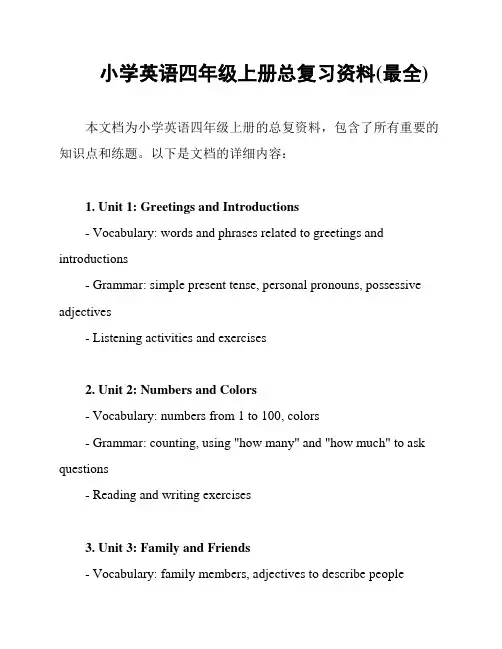
小学英语四年级上册总复习资料(最全)本文档为小学英语四年级上册的总复资料,包含了所有重要的知识点和练题。
以下是文档的详细内容:1. Unit 1: Greetings and Introductions- Vocabulary: words and phrases related to greetings and introductions- Grammar: simple present tense, personal pronouns, possessive adjectives- Listening activities and exercises2. Unit 2: Numbers and Colors- Vocabulary: numbers from 1 to 100, colors- Grammar: counting, using "how many" and "how much" to ask questions- Reading and writing exercises3. Unit 3: Family and Friends- Vocabulary: family members, adjectives to describe people- Grammar: possessive pronouns, present continuous tense- Speaking and listening activities4. Unit 4: Daily Routines- Vocabulary: daily activities, time expressions- Grammar: simple present tense (third person singular)5. Unit 5: Food and Drinks- Vocabulary: types of food and drinks, likes and dislikes- Grammar: using "I like" and "I don't like", expressing preferences - Speaking and listening exercises6. Unit 6: Hobbies and Leisure Time- Vocabulary: hobbies and leisure activities- Grammar: using "can" and "can't" to talk about abilities- Writing and speaking tasks7. Unit 7: Places in the City- Vocabulary: places in the city, prepositions of location- Grammar: using "there is" and "there are" to describe places8. Unit 8: Weather and Seasons- Vocabulary: weather conditions, seasons- Grammar: using present continuous tense to talk about weather以上是小学英语四年级上册的总复习资料,希望能对同学们的学习有所帮助。
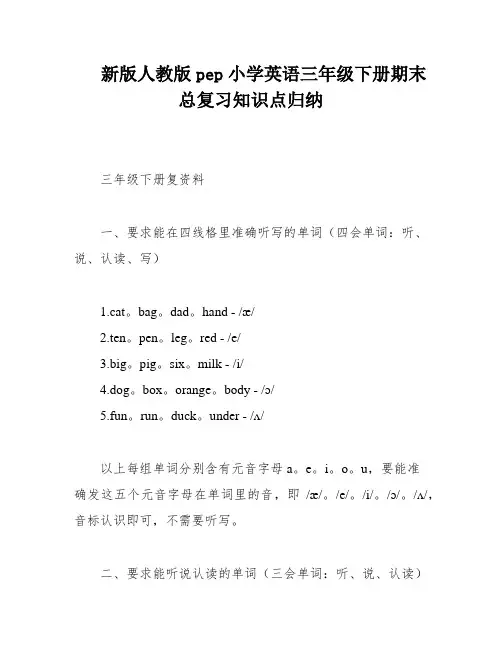
新版人教版pep小学英语三年级下册期末总复习知识点归纳三年级下册复资料一、要求能在四线格里准确听写的单词(四会单词:听、说、认读、写)1.cat。
bag。
dad。
hand - /æ/2.ten。
pen。
leg。
red - /e/3.big。
pig。
six。
milk - /i/4.dog。
box。
orange。
body - /ɔ/5.fun。
run。
duck。
under - /ʌ/以上每组单词分别含有元音字母 a。
e。
i。
o。
u,要能准确发这五个元音字母在单词里的音,即/æ/。
/e/。
/i/。
/ɔ/。
/ʌ/,音标认识即可,不需要听写。
二、要求能听说认读的单词(三会单词:听、说、认读)Unit 1 e back to school!the) UK。
Canada。
(the) USA。
China英国、加拿大、美国、中国she。
he。
student。
teacher。
pupil她、他、学生、教师、小学生Unit 2 My familyfather (dad)。
man。
mother (mum)。
woman爸爸、男人、妈妈、女人sister。
brother。
grandfather (grandpa)。
grandmother (grandma)姐妹、兄弟、爷爷或外公、奶奶或外婆Unit 3 At the zoo括号里的称呼都是前面正式称呼的口头称呼,用于口头交流。
国家首字母要大写,缩写国家前加the,注意the 的发音。
fat。
thin。
tall。
short - 胖的、瘦的、高的、矮的small。
big。
long。
short - 小的、大的、长的、短的Unit 4 Where is my car?本单元都是形容词,可以用It’s… 来表达;表示长度时用long。
short;表示高度时用 tall。
short;注意区分应用 short 的两种不同意思。
in。
on。
under。
chair。
desk - 在…里、在…上、在…下面、椅子、桌子cap。
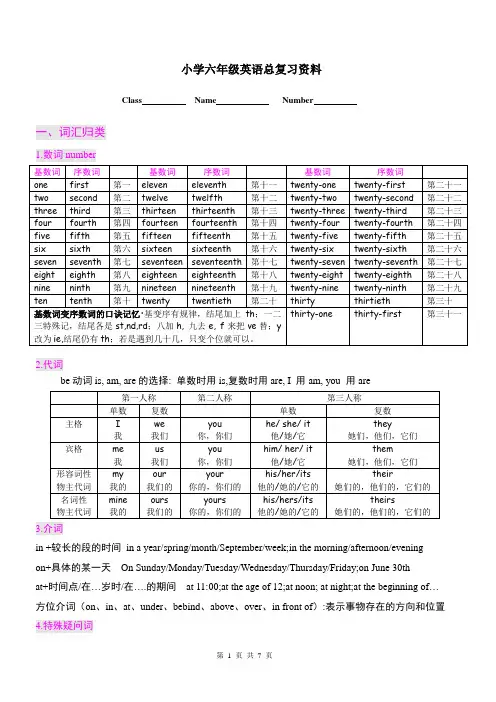
小学六年级英语总复习资料Class Name Number一、词汇归类1.数词number2.代词be动词is, am, are的选择: 单数时用is,复数时用are, I 用am, you 用are3.介词in +较长的段的时间in a year/spring/month/September/week;in the morning/afternoon/eveningon+具体的某一天On Sunday/Monday/Tuesday/Wednesday/Thursday/Friday;on June 30that+时间点/在…岁时/在….的期间at 11:00;at the age of 12;at noon; at night;at the beginning of…方位介词(on、in、at、under、bebind、above、over、in front of):表示事物存在的方向和位置4.特殊疑问词5.同音词I—eye, for—four, where—wear, pear—pair, see—sea, right-- write board—bored, sun—son, hour—our, one—won, here—hear, deer—dear, no—know, there—their, to-- too—two, by-- bye—buy6.缩写形式与完整形式isn’t=is not aren’t=are not I’m=I am it’s=it is can’t=can not could not=couldn’t she’s=she is he’s=he is you’re=you are we’re=we are don’t=do not doesn’t=does not they’re=they are what’s=what is who’s=who is that’s =that is did not=didn’t let’s=let us 二、Let’s spell三、语法点归类1.名词的运用单数名词:一般情况下用a可数名词以元音开头的单词用an (元音字母有:a e i o u)(如:an umbrella/ apple/egg/e-mail/ice cream/orange/umbrella/ elephant)复数名词:一般在词尾加s不可数名词如meat/milk/juice/water/tea/coffee/ soup2.名词单数变复数的规则3.形容词的比较级①形容词比较级的运用:将两个事物或人进行比较要用比较级,句型结构:4.四种时态(一般现在时、现在进行时、一般过去时、一般将来时)⑴一般现在时①用法:表示经常反复发生的动作、存在的状态或习惯性的动作的时态。
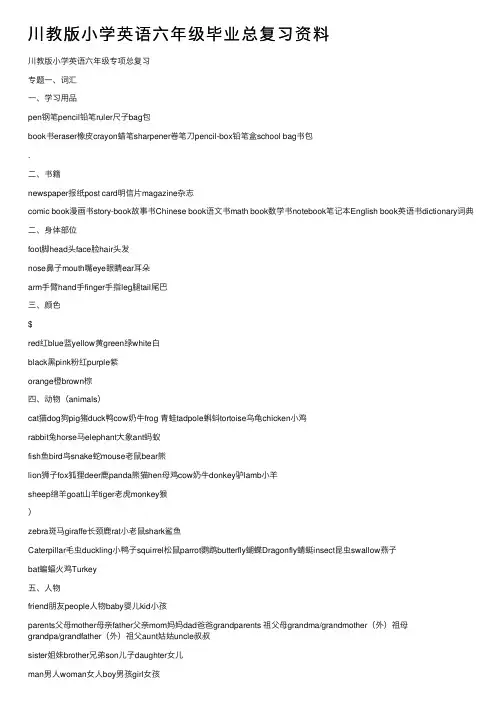
川教版⼩学英语六年级毕业总复习资料川教版⼩学英语六年级专项总复习专题⼀、词汇⼀、学习⽤品pen钢笔pencil铅笔ruler尺⼦bag包book书eraser橡⽪crayon蜡笔sharpener卷笔⼑pencil-box铅笔盒school bag书包.⼆、书籍newspaper报纸post card明信⽚magazine杂志comic book漫画书story-book故事书Chinese book语⽂书math book数学书notebook笔记本English book英语书dictionary词典⼆、⾝体部位foot脚head头face脸hair头发nose⿐⼦mouth嘴eye眼睛ear⽿朵arm⼿臂hand⼿finger⼿指leg腿tail尾巴三、颜⾊$red红blue蓝yellow黄green绿white⽩black⿊pink粉红purple紫orange橙brown棕四、动物(animals)cat猫dog狗pig猪duck鸭cow奶⽜frog 青蛙tadpole蝌蚪tortoise乌龟chicken⼩鸡rabbit兔horse马elephant⼤象ant蚂蚁fish鱼bird鸟snake蛇mouse⽼⿏bear熊lion狮⼦fox狐狸deer⿅panda熊猫hen母鸡cow奶⽜donkey驴lamb⼩⽺sheep绵⽺goat⼭⽺tiger⽼虎monkey猴)zebra斑马giraffe长颈⿅rat⼩⽼⿏shark鲨鱼Caterpillar⽑⾍duckling⼩鸭⼦squirrel松⿏parrot鹦鹉butterfly蝴蝶Dragonfly蜻蜓insect昆⾍swallow燕⼦bat蝙蝠⽕鸡Turkey五、⼈物friend朋友people⼈物baby婴⼉kid⼩孩parents⽗母mother母亲father⽗亲mom妈妈dad爸爸grandparents 祖⽗母grandma/grandmother(外)祖母grandpa/grandfather(外)祖⽗aunt姑姑uncle叔叔sister姐妹brother兄弟son⼉⼦daughter⼥⼉man男⼈woman⼥⼈boy男孩girl⼥孩,Mr.先⽣Miss⼩姐Ms⼥⼠,夫⼈pen pal笔友student学⽣classmate同学⽔果类:Apple苹果orange橙⼦lemon柠檬peach桃⼦梨⼦pear ⾹蕉banana 葡萄grape 芒果mango草莓strawberry 樱桃cherry 荔枝litchis 西⽠watermelon,六、职业teacher教师student学⽣doctor医⽣nurse护⼠engineer⼯程师police警察cleaner清洁⼯worker⼯⼈driver司机farmer农民waiter 服务员singer歌唱家writer作家actor男演员actress⼥演员artist画家policeman(男)警察postman邮递员TV reporter电视台记者七、交通⼯具bike⾃⾏车bus公共汽车train⽕车boat⼩船ship轮船car⼩汽车taxi出租车jeep吉普车Truck货车subway/地铁motor cycle摩托车plane飞机-⼋、地点/场所home家:room房间bedroom卧室bathroom卫⽣间kitchen厨房living room起居室washroom卫⽣间study书房school学校:classroom教室teacher’s office教师办公室Library图书馆art room绘画教室computer room计算机教室music room⾳乐教室playground操场canteen⾷堂Post office邮局police office警察局hospital医院factory⼯⼚cinema电影院bank银⾏farm农场bookstore书店zoo动物园garden花园park公园pet shop宠物商店supermarket超市bookstore书店gym体育馆the Great Wall长城bus stop公交车站!country国家village乡村city城市hometown家乡九、课程Chinese语⽂math数学English英语课science科学Moral Education思想品德课Social Studies社会课.体育课music⾳乐art美术sports体育运动⼗、国家、城市(China/PRC中国America/USA美国England/UK英国Canada/CAN加拿⼤Australia澳⼤利亚New York纽约London伦敦Sydney 悉尼New Zealand 新西兰France 法国Paris 巴黎Hong Kong⾹港Japan⽇本flower花grass草tree树seed种⼦plant 植物rose玫瑰leaf叶⼦rain⾬cloud⽩云sun太阳wind风snow雪stream⼩溪river河流lake湖泊star星星moon⽉亮⼗⼆、星期)Mon. =Monday星期⼀Tues.= Tuesday星期⼆Wed.=Wednesday星期三Thur.=Thursday星期四Fri.= Friday星期五Sat.=Saturday星期六Sun.=Sunday星期天weekend周末week星期、周weekday⼯作⽇⼗三、⽉份Jan. (January) ⼀⽉Feb.(February)⼆⽉Mar.(March)三⽉April四⽉May五⽉June六⽉July七⽉Aug.(August)⼋⽉Sept.(September)九⽉Oct. (October) ⼗⽉Nov.(November)⼗⼀⽉Dec.(December)⼗⼆⽉⼗四、季节spring春summer夏fall/autumn秋winter冬⼗五、⽅位south南north北east东west西left左边right右边straight成直线的⼗六、患病have a fever发烧have a cold感冒have a cough咳嗽have a toothache⽛疼have a headache头疼[have a stomachache 胃疼、肚⼦疼ill⽣病⼗七、数词:基数词one⼀two⼆three三four四five五six六seven七eight⼋nine九ten⼗eleven⼗⼀twelve⼗⼆thirteen⼗三fourteen⼗四fifteen⼗五sixteen⼗六seventeen⼗七eighteen⼗⼋nineteen⼗九twenty⼆⼗thirty三⼗forty四⼗fifty五⼗sixty六⼗seventy七⼗eighty⼋⼗ninety九⼗hundred百'序数词first第⼀second第⼆third第三fourth第四fifth第五eighth第⼋ninth第九twelfth第⼗⼆twentieth第⼆⼗thirtieth第三⼗fortieth第四⼗fiftieth第五⼗sixtieth第六⼗seventieth第七⼗eightieth第⼋⼗ninetieth第九⼗fifty-sixth第五⼗六in在……⾥on在……上;在……时候under在……下⾯near在……的旁边behind在……后边next to与……相邻over在……上⾯in front of在……前⾯at 在……点!on the left在左边on the right在右边⼆⼗、⼼态情绪happy⾼兴的excited兴奋的angry⽣⽓的bored ⽆聊的sad悲伤的tired疲劳的⼆⼗⼀、动词过去式watch----watched 看wash---washed洗clean---cleaned打扫visit---visited看望do---did做go---went去!read---read读,看learn---learned学习eat---ate吃take---took照climb---climbed爬sing—sang唱歌dance---danced跳舞see---saw看见buy---bought买row—rowed划study---studied学习swim—swam游泳have—had有、吃return—returned归回fly---flew放prepare—prepared准备walk---walked步⾏jump---jumped跳leave---left离开play---played玩relax—relaxed放松get—got到达come—came来run—ran跑⼆⼗⼆、时间`表⼀般现在时:this morning(今天上午) this afternoon(今天下午)this evening (今天晚上) every day 每天表将来的:next week(下周) next weekend下周末next year明年next month下个⽉next Sunday下星期天表过去的:last weekend上个周末last week上周last year去年last month上个⽉last Sunday上个星期天three days ago三天前⼆⼗三、书籍comic book(漫画书) post card(明信⽚) newspaper(报纸) magazine(杂志)dictionary(字典)Chinese-book(语⽂书) English-book(英语书) math-book(数学书)note-book(笔记本) story-book(故事书) English-book(英语书)—⼆⼗四、Hobby(爱好)ride a bike--riding a bike(骑⾃⾏车) go swimming-- going swimming去游泳play the violin—playing the violin(拉⼩提琴)Fly a kite-flying a kite放风筝playing basketball打篮球⼆⼗五、第三⼈称单数Look-looks(看) feel-feels(感觉起来)smell-smells闻起来Taste-tastes尝起来sound-sounds听起来get-gets(到达,抵达)live –lives(居住) read--reads(读,看)teach--teaches(教) go--goes(去) watch--watches(看)>Do-does做have-has有,吃,喝⼆⼗六、形容词⽐较级更⾼的shorter更矮的younger更年轻的older更⽼的stronger更强壮的longer更长的smaller更⼩的更廋的hotter更热的bigger更⼤的fatter 更胖的更重的funny-funnier更有趣的easy-easier更容易的early-earlier更早的happy-happier更开⼼的pretty-prettier更漂亮的ugly-uglier更丑的更好的bad-worse更坏的expensive-more expensive更贵的difficult-more difficult更困难的⼆⼗七、三餐-breakfast早餐lunch午饭dinner晚饭⼆⼗⼋、疑问副词1.What is it(它是什么)2. What colour is it(什么颜⾊)day is it today(问今天星期⼏)’s the date today(问某⽉某⽇)’s the weather today(问天⽓)|is the matter with you你怎么了=What’s wrong with you is it(它怎样)time is it(⼏点)many boys are therein our class(我们班有多少个男⽣) much is the pen( 这只钢笔多少钱)How old are you(你⼏岁了)How about(怎么样)=what aboutWhen does she go to school(她什么时候去上学)Which dress is best(哪⼀条连⾐裙最好)Where are you going(你将要去在哪⾥)Why do you like apples(你为什么喜欢苹果).Who is he他是谁Whose book is it它是谁的书When were you born你什么时候出⽣的⼆⼗九、频度副词(⽤在⼀般现在时态中)always(总是) usually(通常)often(经常)sometimes(有时候)never(从来不)三⼗、缩写形式:、1、. 上午2、.下午3、Entrance ⼊⼝4、Exit 出⼝5、1st第⼀2nd第⼆3rd第三4th第四7、What is=What’s 8、Who is=Who’s 9、can not=can’t 10、do not=don’t 11、does not= does n’t 12、did not=did n’t 13、you are=you’re 14、they are=they’re 15、I will=I’ll16、It is=it’s 17、She is=She’s 18、He is=He’s 19、I am=I’m⾷物:1、dumpling 饺⼦2、Zong Zi 粽⼦3、moon-cake ⽉饼[4、noodles⾯条5、fruit⽔果单位名称millimeter(mm)毫⽶centimeter(cm)厘⽶kilometer(km)千⽶foot英尺kilogram(kg)千克gram(g)克ton(t/tn)吨meter(m)⽶There Be 句型:1、A:Is there+单数名词……B:Yes,________No_________<2、A:Are there+复数名词……B:Yes,__________No,___________六年级上册句型1. How do you go to school (你怎样上学)I go by bike. (我乘⾃⾏车去。
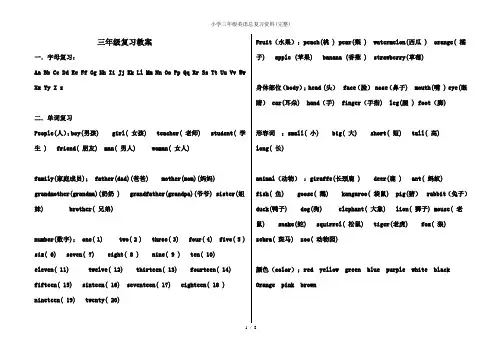
三年级复习教案一.字母复习:Aa Bb Cc Dd Ee Ff Gg Hh Ii Jj Kk Ll Mm Nn Oo Pp Qq Rr Ss Tt Uu Vv Ww Xx Yy Z z二.单词复习People(人);boy(男孩) girl( 女孩) teacher( 老师) student( 学生 ) friend( 朋友) man( 男人) woman( 女人)family(家庭成员); father(dad)(爸爸) mother(mom)(妈妈) grandmother(grandma)(奶奶 ) grandfather(grandpa)(爷爷) sister(姐妹) brother( 兄弟)number(数字); one( 1) two( 2 ) three( 3) four( 4) five( 5 ) six( 6) seven( 7) eight( 8 ) nine( 9 ) ten( 10)eleven( 11) twelve( 12) thirteen( 13) fourteen( 14) fifteen( 15) sixteen( 16) seventeen( 17) eighteen( 18 ) nineteen( 19) twenty( 20) Fruit(水果);peach(桃 ) pear(梨 ) watermelon(西瓜 ) orange( 橘子) apple (苹果) banana (香蕉 ) strawberry(草莓)身体部位(body);head (头) face(脸) nose(鼻子) mouth(嘴 ) eye(眼睛) ear(耳朵) hand(手) finger(手指) leg(腿 ) foot(脚)形容词;small( 小) big( 大) short( 短) tall( 高)long( 长)animal(动物):giraffe(长颈鹿 ) deer(鹿 ) ant( 蚂蚁)fish( 鱼) goose( 鹅) kangaroo( 袋鼠) pig(猪) rabbit(兔子)duck(鸭子) dog(狗) elephant( 大象) lion( 狮子) mouse( 老鼠) snake(蛇) squirrel( 松鼠) tiger(老虎) fox( 狼) zebra( 斑马) zoo( 动物园)颜色(color);red yellow green blue purple white black Orange pink brown饮料(drink):Coke( 可乐 ) coffee( 咖啡) milk(牛奶 )water( 水) juice( 汁)食物(food):ice-cream( 冰激凌) egg( 鸡蛋) hamburger(汉堡包) hot dog( 热狗) cake(蛋糕) chicken(鸡肉) bread(面包)国家(country);CAN(加拿大) PRC(中国) UK(英国) USA(美国) China(中国) America (美国) Canada(加拿大)其他desk( 书桌) chair(椅子) bag(包) walkman(随身听) lamp( 灯) key( 钥匙) night( 夜晚) rain( 雨) rainbow( 彩虹)umbrella( 雨伞) window( 窗户) wind( 风) box( 盒子)toy(玩具)bus( 公交车 ) bike(自行车 ) taxi( 出租车) jeep( 吉普车)三、重点句型复习Unit 11. A: Nice to see you again. 再次见到你我很高兴B: Nice to see you, too.再次见到你我也很高兴2. A: Where are you from 你来自哪里?B: I’m from China./America/Canada/ PRC/ USA/ CAN/ UK我来自中国,美国,加拿大……….3. A: I’m sorry. 对不起B: It’s OK.没关系4.有人敲门你说:Come in, please.5.怎么用英语欢迎同学回校:Welcome back to school.Unit 21. A: Who’s this(that) man(boy)那位(男士)男孩是谁?B: He’s my father(brother).他是我的(爸爸)兄弟。
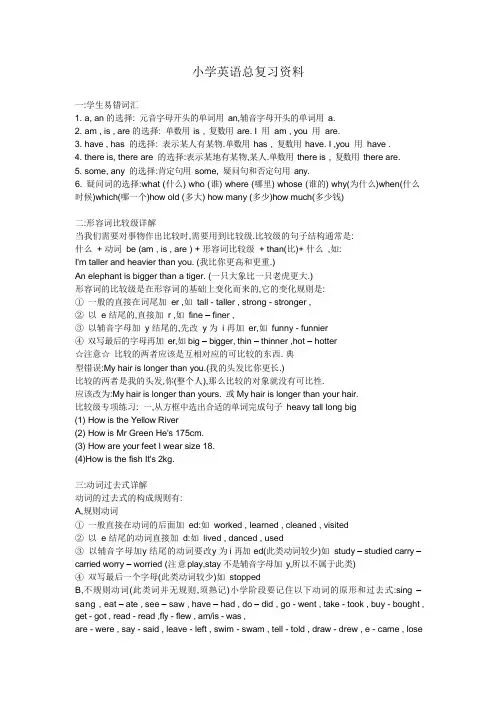
小学英语总复习资料一:学生易错词汇1. a, an 的选择: 元音字母开头的单词用an,辅音字母开头的单词用a.2. am , is , are 的选择: 单数用is , 复数用are. I 用am , you 用are.3. have , has 的选择: 表示某人有某物.单数用has , 复数用have. I ,you 用have .4. there is, there are 的选择:表示某地有某物,某人.单数用there is , 复数用there are.5. some, any 的选择:肯定句用some, 疑问句和否定句用any.6. 疑问词的选择:what (什么) who (谁) where (哪里) whose (谁的) why(为什么)when(什么时候)which(哪一个)how old (多大) how many (多少)how much(多少钱)二:形容词比较级详解当我们需要对事物作出比较时,需要用到比较级.比较级的句子结构通常是:什么+ 动词be (am , is , are ) + 形容词比较级+ than(比)+ 什么,如:I'm taller and heavier than you. (我比你更高和更重.)An elephant is bigger than a tiger. (一只大象比一只老虎更大.)形容词的比较级是在形容词的基础上变化而来的,它的变化规则是:①一般的直接在词尾加er ,如tall - taller , strong - stronger ,②以e 结尾的,直接加r ,如fine – finer ,③以辅音字母加y 结尾的,先改y 为i 再加er,如funny - funnier④双写最后的字母再加er,如big – bigger, thin – thinner ,hot – hotter☆注意☆比较的两者应该是互相对应的可比较的东西. 典型错误:My hair is longer than you.(我的头发比你更长.)比较的两者是我的头发,你(整个人),那么比较的对象就没有可比性.应该改为:My hair is longer than yours. 或My hair is longer than your hair.比较级专项练习: 一,从方框中选出合适的单词完成句子heavy tall long big(1) How is the Yellow River(2) How is Mr Green He's 175cm.(3) How are your feet I wear size 18.(4)How is the fish It's 2kg.三:动词过去式详解动词的过去式的构成规则有:A,规则动词①一般直接在动词的后面加ed:如worked , learned , cleaned , visited②以e 结尾的动词直接加d:如lived , danced , used③以辅音字母加y 结尾的动词要改y 为i 再加ed(此类动词较少)如study – studied carry –carried worry – worried (注意play,stay 不是辅音字母加y,所以不属于此类)④双写最后一个字母(此类动词较少)如stoppedB,不规则动词(此类词并无规则,须熟记)小学阶段要记住以下动词的原形和过去式:sing –sang , eat – ate , see – saw , have – had , do – did , go - went , take - took , buy - bought , get - got , read - read ,fly - flew , am/is - was ,are - were , say - said , leave - left , swim - swam , tell - told , draw - drew , e - came , lose- lost , find - found , drink - drank , hurt - hurt , feel - felt四:动词现在分词详解动词的ing 形式的构成规则:①一般的直接在后面加上ing ,如doing ,going ,working ,singing ,eating②以e 结尾的动词,要先去 e 再加ing ,如having , writing③双写最后一个字母的(此类动词极少)有:running , swimming , sitting , getting五:人称代词与物主代词一、人称代词二、物主代词六:句型专项归类1. 肯定句:是指用肯定的语气来陈述的句子,如:I'm a student. She is a doctor. He works in a hospital.There are four fans in our classroom. He will eat lunch at 12:00. I watched TV yesterday evening.2,否定句:含有否定词或表示否定意义词的句子,如:I'm not a student. She is not (isn't) a doctor.He does not (doesn't) work in a hospital. There are not (aren't) four fans in our classroom. He will not (won't) eat lunch at 12:00. I did not (didn't) watch TV yesterday evening.☆注意☆小结:否定句主要是在肯定句的基础上加上了否定词"not".有动词be 的句子则"not"加在be 后面,可缩写成"isn't,aren't",但am not 一般都分开写.没有动词be 的句子则要先在主要动词的前面加上一个助动词(do,does,did),然后在它后面加上"not",你也可以把它们缩写在一起如"don't , doesn't , didn't ).这三个助动词要根据人称和时态来选择,其中"does" 只用于一般现在时主语是第三人称单数的情况,而"did"只用于一般过去时,不论主语是什么人称和数,都用"did" .3,一般疑问句:是指询问事实的句子,此类句子必须用"yes",或"no"来回答.如:Are you a student Yes, I am / No, I'm not.Is she a doctor Yes, she is. / No, she isn't.Does he work in a hospital Yes, he does. / No, he doesn't.Are there four fans in our classroom Yes, there are. / No, there aren't.Are you going to buy a ic book tonight Yes, I am. / No, I am not. (Yes, we are. / No, we aren't.)Will he eat lunch at 12:00 Yes, I will. / No, I will not(won't).Are they swimming Yes, they are. / No, they aren't.Did you watch TV yesterday evening Yes, I did. / No, I didn't.☆注意☆小结:一般疑问句是在肯定句的基础上,①把动词be 调到首位,其他照写,末尾标点符号变成问号即可.②没有动词be 的句子则要在句首加上一个助动词(do,does,did)再把紧跟在后面的动词变回原形,末尾标点符号变成问号即可.这三个助动词也要根据人称和时态来选择,其中"does"只用于一般现在时主语是第三人称单数的情况,而"did"只用于一般过去时,不论主语是什么人称和数,都用"did" .一般疑问句有个重要的原则就是问和答要一致,即问句里的第一个单词(助动词)和简略答句里的这个词是一致的.4,特殊疑问句:以特殊疑问词(what , where , who , which , when , whose , why , how 等)开头引导的句子.此类句子应该问什么就答什么,不能用"yes ,no"来回答.如:What is this It's a puter.What does he do He's a doctor.Where are you going I'm going to Beijing.Who played football with you yesterday afternoon Mike.Which season do you like best Summer.When do you usually get up I usually get up at 6:30.Whose skirt is this It's Amy's.Why do you like spring best Because I can plant trees.How are you I'm fine. / I'm happy.How did you go to Xinjiang I went to Xinjiang by train.☆其中how 又可以和其他一些形容词连用组成特殊疑问词组用来提问,如:how many(多少(数量)), how much(多少(钱)), how tall(多高), how long(多长), how big(多大), how heavy(多重)例句:How many pencils do you have I have three pencils.How many girls can you see I can see four girls.How many desks are there in your classroom There are 51.☆小结:how many 用来提问可数名词的数量,主要有以上三种句式搭配,How many + 名词复数+ do you have 你有多少……How many + 名词复数+ can you see 你能看见多少……How many + 名词复数+ are there… 有多少……七:完全,缩略形式: I'm=I am he's=he is she's=she is they're=they are you're=you are there's=there is they're=they are can't=can not don't=do not doesn't=does not isn't=is not aren't=are not let's=let us won't=will not I'll=I will wasn't=was not总结:通常情况下,'m 即am,'s 即is(但let's=let us), 're 即are ,n't 即not (但can't=can not) 八:小学英语词汇不完全归类表学习用品(school things):pen 钢笔pencil 铅笔pencil-case 铅笔盒ruler 尺子book 书bag 包ic book 漫画书post card 明信片newspaper 报纸schoolbag 书包eraser 橡皮crayon 蜡笔sharpener 卷笔刀story-book 故事书notebook 笔记本Chinese book 语文书English book 英语书math book 数学书magazine 杂志dictionary 词典人体(body):foot 脚head 头face 脸hair 头发nose 鼻子mouth 嘴eye 眼睛ear 耳朵arm 手臂hand 手finger 手指leg 腿tail 尾巴颜色(colours):red 红blue 蓝yellow 黄green 绿white 白black 黑pink 粉红purple 紫orange 橙brown 棕动物(animals):cat 猫dog 狗pig 猪duck 鸭rabbit 兔horse 马elephant 大象ant 蚂蚁fish 鱼bird 鸟eagle 鹰beaver 海狸snake 蛇mouse 老鼠squirrel 松鼠kangaroo 袋鼠monkey 猴panda 熊猫bear 熊lion 狮子tiger 老虎fox 狐狸zebra 斑马deer 鹿giraffe 长颈鹿goose 鹅hen 母鸡turkey火鸡lamb 小羊sheep 绵羊goat山羊cow 奶牛donkey 驴squid 鱿鱼lobster 龙虾shark 鲨鱼seal 海豹sperm whale 抹香鲸killer whale 虎鲸人物(people):friend 朋友boy 男孩girl 女孩mother 母亲father 父亲sister 姐妹brother 兄弟uncle 叔叔;舅舅man 男人woman 女人Mr.先生Miss 小姐lady 女士;小姐mom 妈妈dad 爸爸parents 父母grandparents 祖父母grandma/grandmother( 外) 祖母grandpa/grandfather(外)祖父aunt 姑姑cousin 堂(表)兄弟;堂(表)姐妹son 儿子daughter 女儿baby 婴儿kid 小孩classmate 同学queen 女王visitor 参观者neighbour 邻居principal 校长university student 大学生pen pal 笔友tourist 旅行者people 人物robot 机器人职业(jobs):teacher 教师student 学生doctor 医生nurse 护士driver 司机farmer 农民singer 歌唱家writer 作家actor 男演员actress 女演员artist 画家TV reporter 电视台记者engineer 工程师accountant 会计policeman(男)警察salesperson 销售员cleaner 清洁工baseball player 棒球运动员assistant 售货员police 警察食品,饮料(food & drink):rice 米饭bread 面包beef 牛肉milk 牛奶water 水egg 蛋fish 鱼tofu 豆腐cake 蛋糕hot dog 热狗hamburger 汉堡包French fries 炸薯条cookie 曲奇biscuit 饼干jam 果酱noodles 面条meat 肉chicken 鸡肉pork 猪肉mutton 羊肉vegetable 蔬菜salad 沙拉soup 汤ice 冰ice-cream 冰淇淋Coke 可乐juice 果汁tea 茶coffee 咖啡breakfast 早餐lunch 午餐dinner/supper 晚餐meal 一餐水果,蔬菜(fruit & vegetables):apple 苹果banana 香蕉pear 梨orange 橙watermelon 西瓜grape 葡萄eggplant 茄子green beans 青豆tomato 西红柿potato 土豆peach 桃strawberry 草莓cucumber 黄瓜onion 洋葱carrot 胡萝卜cabbage 卷心菜衣服(clothes):jacket 夹克衫shirt 衬衫T-shirt 丅恤衫skirt 短裙子dress 连衣裙jeans 牛仔裤pants 长裤socks 袜子shoes 鞋子sweater 毛衣coat 上衣raincoat 雨衣shorts 短裤sneakers 网球鞋slippers 拖鞋sandals 凉鞋boots 靴子hat(有沿的)帽子cap 便帽sunglasses 太阳镜tie 领带scarf 围巾gloves 手套trousers 裤子cloth 布交通工具(vehicles):bike 自行车bus 公共汽车train 火车boat 小船ship 轮船yacht 快艇car 小汽车taxi 出租车jeep 吉普车van 小货车;面包车plane/airplane 飞机subway/underground 地铁motor cycle 摩托车杂物(other things): window 窗户door 门desk 课桌chair 椅子bed 床puter 计算机board 写字板fan 风扇light 灯teacher's desk 讲台picture 图画;照片wall 墙壁floor 地板curtain 窗帘trash bin 垃圾箱closet 壁橱mirror 镜子end table 床头柜football/soccer 足球present 礼物walkman 随身听lamp 台灯phone 电话sofa 沙发shelf 书架fridge 冰箱table 桌子TV 电视air-conditioner 空调key 钥匙lock 锁photo 照片chart 图表plate 盘子knife 刀fork 叉spoon 勺子chopsticks 筷子pot 锅gift 礼物toy 玩具doll 洋娃娃ball 球balloon 气球kite 风筝jigsaw puzzle 拼图游戏box 盒子umbrella 伞zipper 拉链violin 小提琴yo-yo 溜溜球nest 鸟窝hole 洞tube 管子toothbrush 牙刷menu 菜单e-card 电子卡片e-mail 电子邮件traffic light 交通灯money 钱medicine 药地点(locations):home 家room 房间bedroom 卧室bathroom 卫生间living room 起居室kitchen 厨房classroom 教室school 学校park 公园library 图书馆post office 邮局police office 警察局hospital 医院cinema 电影院bookstore 书店farm 农场zoo 动物园garden 花园study 书房playground 操场canteen 食堂teacher's office 教师办公室library 图书馆gym 体育馆washroom 卫生间art room 绘画教室puter room 计算机教室music room 音乐教室TV room 电视机房flat 公寓pany 公司factory 工厂fruit stand 水果摊pet shop 宠物商店nature park 自然公园theme park 主题公园science museum 科学博物馆the Great Wall 长城supermarket 超市bank 银行country 国家village 乡村city 城市hometown 家乡bus stop 公交车站课程(classes): sports 体育运动science 科学Moral Education 思想品德课Social Studies 社会课Chinese 语文math 数学PE 体育课English 英语课国家,城市(countries & cities): China/PRC 中国America/USA 美国UK 联合王国England 英国Canada/CAN 加拿大Australia 澳大利亚New York 纽约London 伦敦Sydney 悉尼Moscow 莫斯科Cairo 开罗气象(weather): cold 寒冷的warm 温暖的cool 凉爽的snowy 下雪的sunny 晴朗的hot 炎热的rainy 下雨的windy 有风的cloudy 多云的weather report 天气预报景物(nature): river 河流lake 湖泊stream 河;溪forest 森林path 小道road 公路house 房子bridge 桥building 建筑物rain 雨cloud 云sun 太阳mountain 山sky 天空rainbow 彩虹wind 风air 空气moon 月亮植物(plants): flower 花grass 草tree 树seed 种子sprout 苗plant植物rose 玫瑰leaf 叶子星期(week): Monday 星期一Tuesday 星期二Wednesday 星期三Thursday 星期四Friday 星期五Saturday 星期六Sunday 星期天weekend 周末月份(months): Jan. (January)一月Feb.(February)二月Mar.(March) 三月April 四月May 五月June 六月July 七月Aug.(August)八月Sept.(September)九月Oct.(October)十月Nov.(November)十一月Dec.(December)十二月季节(seasons): spring 春summer 夏fall/autumn 秋winter 冬方位(directions): south 南north 北east 东west 西left 左边right 右边患病(illness): have a fever 发烧hurt 疼痛have a cold 感冒have a toothache 牙疼have a headache 头疼have a sore throat 喉咙疼数词(numbers): one 一two 二three 三four 四five 五six 六seven 七eight 八nine 九ten 十eleven 十一twelve 十二thirteen 十三fourteen 十四fifteen 十五sixteen 十六seventeen 十七eighteen十八nineteen 十九twenty 二十thirty 三十forty 四十fifty 五十sixty 六十seventy 七十eighty 八十ninety 九十forty-two 四十二hundred 百one/a hundred and thirty-six 一百三十六first 第一second 第二third 第三fourth 第四fifth 第五eighth 第八ninth 第九twelfth 第十二twentieth 第二十thirtieth 第三十fortieth 第四十fiftieth 第五十sixtieth 第六十seventieth 第七十eightieth 第八十ninetieth 第九十fifty-sixth 第五十六形容词(adj.): big 大的small 小的long 长的tall 高的short 短的;矮的young 年轻的old 旧的;老的strong 健壮的thin 瘦的active 积极活跃的quiet 安静的nice 好看的kind 和蔼亲切的strict 严格的smart 聪明的funny 滑稽可笑的tasty 好吃的sweet 甜的salty 咸的sour 酸的fresh 新鲜的favourite 最喜爱的clean 干净的tired 疲劳的excited 兴奋的angry 生气的happy 高兴的bored 无聊的sad 忧愁的taller 更高的shorter 更矮的stronger 更强壮的older年龄更大的younger 更年轻的bigger 更大的heavier 更重的longer 更长的thinner 更瘦的smaller 更小的good 好的fine 好的great 很好的heavy 重的new 新的fat 胖的happy 快乐的right 对的hungry 饥饿的cute 逗人喜爱的little 小的lovely 可爱的beautiful 漂亮的colourful 色彩鲜艳的pretty 漂亮的cheap 便宜的expensive 昂贵的juicy 多汁的tender 嫩的healthy 健康的ill 有病的helpful 有帮助的high 高的easy 简单的proud 骄傲的sick 有病的better 更好的higher 更高的介词(prep.): in 在……里on 在……上;在……时候under 在……下面near 在……的旁边behind 在……后边next to 与……相邻over 在……上面in front of 在……前面代词(pron.): I 我we 我们you 你;你们he 他she 她it 它they 他(她, 它)们my 我的our 我们的your 你的;你们的his 他的her 她的动词(v.):play(.ed) 玩;踢swim(swam) 游泳skate 滑冰fly(flew) 飞jump 跳walk 走run(ran) 跑climb 爬fight(fought) 打架swing(swung) 荡eat(ate) 吃sleep(slept) 睡觉like 像, 喜欢have(had)有;吃turn 转弯buy(bought)买take(took)买;带live 居住teach(taught) 教go(went) 去study(studied) 学习learn 学习sing(sang)唱歌dance 跳舞row 划do(did)做do homework 做作业do housework 做家务watch TV 看电视read(read) books 读书cook the meals 做饭water the flowers 浇花sweep(swept) the floor 扫地clean the bedroom 打扫卧室make(made) the bed 铺床set(set) the table 摆饭桌wash the clothes 洗衣服do the dishes 洗碗碟use a puter 使用计算机do morning exercises 晨练;做广播操eat breakfast 吃早饭eat dinner 吃晚饭go to school 上学have English class 上英语课play sports 进行体育运动get(got)up 起床climb mountains 爬山go shopping 买东西play the piano 弹钢琴visit grandparents 看望(外)祖父母go hiking 去远足fly kites 放风筝make a snowman 堆雪人plant trees 种树draw(drew) pictures 画画cook dinner 做饭read a book 看书answer the phone 接电话listen to music 听音乐clean the room 打扫房间write(wrote) a letter 写信write an e-mail 写电子邮件drink(drank) water 喝水take pictures 照相watch insects 观察昆虫pick up leaves 采摘树叶do an experiment 做实验catch butterflies 捉蝴蝶count insects 数昆虫collect insects 收集昆虫collect leaves 收集树叶write a report 写报告play chess 下棋have a picnic 举行野餐get to 到达ride(rode) a bike 骑自行车play the violin 拉小提琴make kites 制作风筝collect stamps 集邮meet(met)见面wele 欢迎thank 谢谢love 爱work 工作drink(drank)喝taste 尝smell 闻feed(fed)喂养shear 剪milk 挤奶look 看guess 猜help 帮助pass 传递show 展示use 使用clean 打扫open 打开close 关上put 放paint 绘画tell(told)告诉kick 踢bounce 反弹ride(rode) 骑stop(stopped) 停wait 等find(found)寻找到drive(drove)驾驶fold 折send(sent)寄wash 洗shine 照耀bee 变成feel(felt)感觉到think(thought)思考meet(met) 遇见fall(fell)落下leave(left)离开wake(woke) up 醒来put on 穿上take off 脱掉hang up 挂起wear(wore)穿go home 回家go to bed 上床睡觉play puter games 玩电脑游戏play chess 下棋empty the trash 倒垃圾put away the clothes 收拾衣服get off 下车take a trip 去旅行read a magazine 读杂志go to the cinema 去看电影go straight 向前直走一、看字写拼音(你能写正确吗?)嗡( )朗润( )酝酿( ) 卖弄( )喉咙( )应和( )嘹亮( ) 烘托( )静默( )风筝( )抖擞( ) 健壮( )呼朋引伴( ) 花枝招展( ) 镶()单单()安适()着落() 慈善()肌肤( ) 秀气( )宽敞( )空灵( )贮蓄( ) 澄清( ) 地毯( )蝉( )花苞( )娇媚( )彩棱镜( )粗犷( ) 睫毛( )衣裳( )铃铛( ) 端庄( )静谧( ) 屋檐( ) 凄冷( )化妆() 莅临 ()造访() 吝啬( )淅沥()干涩()草垛() 绿茵茵 () 咄咄逼人( )二、看拼音写汉字(他们可是很难的哦!挑战一下吧)tān huàn bào nù chén jì shì nòng chuí dǎ( ) ( ) ( ) ( ) ( )qiáo cuìyāng qiúxùdāo juébiédàn yǎ( ) ( ) ( ) ( ) ( )gāo jiélàn màn fān lái fùqùxǐ chū wàng wài ( ) ( ) ( ) ( ) xìn fúfēn qíqǔjuéyīshàliǎng quán ( ) ( ) ) ) ) lín lín gèdéqísuǒdìgěn nì xiào mùdǎo gào zǐmèi(tíng )páihuá)zhē bì)xīn) )liúzhuǎn yīn bì)( ) ) ) ) ) )三、古诗文默写:(你还会背吗?)(1)水何澹澹,。
毕业班小学英语总复习资料一:学生易错词汇1. a, an的选择: 元音字母开头的单词用an,辅音字母开头的单词用a.2. am , is , are的选择: 单数用is , 复数用are. I 用 am , you 用 are.3. have , has 的选择: 表示某人有某物.单数用has , 复数用have. I ,you 用 have .4. there is, there are 的选择:表示某地有某物,某人.单数用there is , 复数用there are.5. some, any 的选择:肯定句用some, 疑问句和否定句用any.6. 疑问词的选择:what (什么) who (谁) where (哪里) whose (谁的) why(为什么)when(什么时候)which(哪一个)how old (多大) how many (多少)how much(多少钱)二:形容词比较级详解当我们需要对事物作出比较时,需要用到比较级.比较级的句子结构通常是:什么 + 动词be (am , is , are ) + 形容词比较级 + than(比)+ 什么 ,如:I'm taller and heavier than you. (我比你更高和更重.)An elephant is bigger than a tiger. (一只大象比一只老虎更大.)形容词的比较级是在形容词的基础上变化而来的,它的变化规则是:①一般的直接在词尾加er ,如 tall - taller , strong - stronger ,②以e结尾的,直接加r ,如 fine – finer ,③以辅音字母加y结尾的,先改y为i再加er,如funny - funnier④双写最后的字母再加er,如big – bigger, thin –thinner ,hot – hotter☆注意☆比较的两者应该是互相对应的可比较的东西.典型错误:My hair is longer than you.(我的头发比你更长.) 比较的两者是我的头发,你(整个人),那么比较的对象就没有可比性.应该改为:My hair is longer than yours. 或My hair is longer than your hair.比较级专项练习: 一,从方框中选出合适的单词完成句子 heavy tall long big(1) How is the Yellow River(2) How is Mr Green He's 175cm.(3) How are your feet I wear size 18.(4)How is the fish It's 2kg.三:动词过去式详解动词的过去式的构成规则有:A,规则动词①一般直接在动词的后面加ed:如 worked , learned , cleaned , visited②以e结尾的动词直接加d:如 lived , danced , used③以辅音字母加y结尾的动词要改y为i再加ed(此类动词较少)如 study – studied carry – carried worry – worried (注意play,stay不是辅音字母加y,所以不属于此类)④双写最后一个字母(此类动词较少)如 stoppedB,不规则动词(此类词并无规则,须熟记)小学阶段要记住以下动词的原形和过去式:sing –sang , eat –ate , see –saw , have – had , do – did , go - went , take - took , buy - bought , get - got , read - read ,fly - flew , am/is - was ,are - were , say - said , leave - left , swim - swam , tell - told , draw - drew , come - came , lose - lost , find - found , drink - drank , hurt - hurt , feel - felt四:动词现在分词详解动词的ing形式的构成规则:①一般的直接在后面加上ing , 如doing , going , working , singing , eating②以e 结尾的动词,要先去e再加ing ,如having , writing③双写最后一个字母的(此类动词极少)有:running , swimming , sitting , getting五:人称代词与物主代词一、人称代词二、物主代词六:句型专项归类1.肯定句:是指用肯定的语气来陈述的句子,如:I'm a student. She is a doctor. He works in a hospital.There are four fans in our classroom. He will eat lunch at12:00. I watched TV yesterday evening.2,否定句:含有否定词或表示否定意义词的句子,如:I'm not a student. She is not (isn't) a doctor.He does not (doesn't) work in a hospital. There are not (aren't) four fans in our classroom.He will not (won't) eat lunch at 12:00. I did not (didn't) watch TV yesterday evening.☆注意☆小结:否定句主要是在肯定句的基础上加上了否定词"not".有动词be的句子则"not"加在be后面,可缩写成"isn't,aren't",但am not 一般都分开写.没有动词be的句子则要先在主要动词的前面加上一个助动词(do,does,did),然后在它后面加上"not",你也可以把它们缩写在一起如"don't , doesn't , didn't ).这三个助动词要根据人称和时态来选择,其中"does"只用于一般现在时主语是第三人称单数的情况,而"did"只用于一般过去时,不论主语是什么人称和数,都用"did" . 3,一般疑问句:是指询问事实的句子,此类句子必须用"yes",或"no"来回答.如:Are you a student Yes, I am / No, I'm not.Is she a doctor Yes, she is. / No, she isn't.Does he work in a hospital Yes, he does. / No, he doesn't. Are there four fans in our classroom Yes, there are. / No, there aren't.Are you going to buy a comic book tonight Yes, I am. / No,I am not. (Yes, we are. / No, we aren't.)Will he eat lunch at 12:00 Yes, I will. / No, I willnot(won't).Are they swimming Yes, they are. / No, they aren't.Did you watch TV yesterday evening Yes, I did. / No, I didn't. ☆注意☆小结:一般疑问句是在肯定句的基础上,①把动词be调到首位,其他照写,末尾标点符号变成问号即可.②没有动词be的句子则要在句首加上一个助动词(do,does,did)再把紧跟在后面的动词变回原形,末尾标点符号变成问号即可.这三个助动词也要根据人称和时态来选择,其中"does"只用于一般现在时主语是第三人称单数的情况,而"did"只用于一般过去时,不论主语是什么人称和数,都用"did" .一般疑问句有个重要的原则就是问和答要一致,即问句里的第一个单词(助动词)和简略答句里的这个词是一致的.4,特殊疑问句:以特殊疑问词(what , where , who , which , when , whose , why , how等)开头引导的句子.此类句子应该问什么就答什么,不能用"yes ,no"来回答.如:What is this It's a computer.What does he do He's a doctor.Where are you going I'm going to Beijing.Who played football with you yesterday afternoon Mike.Which season do you like best Summer.When do you usually get up I usually get up at 6:30. Whose skirt is this It's Amy's.Why do you like spring best Because I can plant trees. How are you I'm fine. / I'm happy.How did you go to Xinjiang I went to Xinjiang by train. ☆其中how又可以和其他一些形容词连用组成特殊疑问词组用来提问,如: how many(多少(数量)), how much(多少(钱)), how tall(多高), how long(多长), how big(多大), how heavy(多重)例句:How many pencils do you have I have three pencils. How many girls can you see I can see four girls.How many desks are there in your classroom There are 51. ☆小结:how many 用来提问可数名词的数量,主要有以上三种句式搭配,How many + 名词复数 + do you have 你有多少……How many + 名词复数 + can you see 你能看见多少……How many + 名词复数 + are there…有多少……七:完全,缩略形式: I'm=I am he's=he is she's=she isthey're=they are you're=you are there's=there isthey're=they are can't=can not don't=do not doesn't=doesnot isn't=is not aren't=are not let's=let us won't=will not I'll=I will wasn't=was not总结:通常情况下,'m即am,'s即is(但 let's=let us), 're即are ,n't即not (但can't=can not)。
PEP小学英语语法要点及习题复习资料一、名词复数规则二、1.一般情况下,直接加-s,如:book-books, bag-bags, cat-cats, bed-beds三、2.以s. x. sh. ch结尾,加-es,如:bus-buses, box-boxes, brush-brushes, watch-watches四、3.以“辅音字母+y”结尾,变y为i, 再加-es,如:family-families, strawberry-strawberries五、4.以“f或fe”结尾,变f或fe为v, 再加-es,如:knife-knives六、5.不规则名词复数:七、man-men, woman-women, policeman-policemen, policewoman-policewomen, mouse-mice八、child-children九、foot-feet,.tooth-teeth十、fish-fish, people-people, Chinese-Chinese, Japanese-Japanese十一、写出下列各词的复数十二、I ____him ___ this _____her ______watch ______child _______photo ________diary day________ foot________ book_______ dress ________tooth_______ sheep box_______strawberry_____thief____peach______sandwich______man______woman____十三、一般现在时十四、一般现在时基本用法介绍十五、【No. 1】一般现在时的功能十六、 1.表示事物或人物的特征、状态。
如:The sky is blue.天空是蓝色的。
十七、 2.表示经常性或习惯性的动作。
六年级英语总复习资料小学英语总复习一:学生易错词汇1. a, an的选择: 元音字母开头的单词用an,辅音字母开头的单词用a.2 am , is , are的选择: 单数用is , 复数用are. I 用am , you 用are.3 have , has 的选择: 表示某人有某物。
单数用has , 复数用have. I ,you 用have .4. there is, there are 的选择:表示某地有某物,某人。
单数用there is , 复数用there are.5. some, any 的选择:肯定句用some, 疑问句和否定句用any.6. 疑问词的选择:what (什么) who (谁) where (哪里) whose (谁的) why(为什么)when(什么时候)which(哪一个)how old (多大) how many (多少)how much(多少钱)二:形容词比较级详解当我们需要对事物作出比较时,需要用到比较级。
比较级的句子结构通常是:什么+ 动词be (am , is , are ) + 形容词比较级+ than(比)+ 什么,如:I’m taller and heavier than you. (我比你更高和更重。
)An elephant is bigger than a tiger. (一只大象比一只老虎更大。
)形容词的比较级是在形容词的基础上变化而来的,它的变化规则是:①一般的直接在词尾加er ,如tall - taller , strong - stronger ,②以e结尾的,直接加r ,如fine – finer ,③以辅音字母加y结尾的,先改y为i再加er,如funny - funnier④双写最后的字母再加er,如big – bigger, thin – thinner ,hot – hotter☆注意☆比较的两者应该是互相对应的可比较的东西。
典型错误:My hair is longer than you.(我的头发比你更长。
小学英语毕业总复习资料国际音标[p] [t] [d] [k] [ɡ] [f] [v] [ʃ] [tʃ] [s] [z] [ʒ] [dʒ] [tr] [dr] [ts] [dz] [θ] [ð] [h] [m] [n] [ŋ] [l] [r] [w] [j] [i:] [e] [æ] [ə:] [ə] [a:] [ʌ] [u:] [ɔ:] [ɔ][ai] [ei] [ɔi] [iə] [ɛə] [uə] [au] [ əu]有关的词汇(请孩子自己查找)人称(I,you…)、动物、交通工具、颜色、家庭成员、日常用品、身体部位、数词、衣服鞋袜、国名、形容词(描述外形特征的词)、动词(表示行为动作的词)、方位介词(前后上下……)主食(饭,面包,面条,蛋糕…)、水果、饮料、疑问词(wh-开头的词语)……话题关于姓名的对话、询问年龄、关于颜色、关于爱好、关于拥有(×××有……)、关于问好、打招呼、关于选择、指向(如:这是……?)、问数量、问来自哪里、问“你在做什么”、问价格、问能力(Can you…)、问出行方式、提出请求(如:May I have…?)、命令与禁止、问是谁、问是谁的、提建议(Let’s…)、问最喜欢的动物是什么以及书上的有关对话等等☆形容词的比较级☆当我们需要对事物作出比较时,需要用到比较级。
比较级的句子结构通常是:什么+ 动词be (am , is , are ) + 形容词比较级+ than(比)+ 什么,如:I’m taller and heavier than you. (我比你更高和更重。
)An elephant is bigger than a tiger. (一只大象比一只老虎更大。
)形容词的比较级是在形容词的基础上变化而来的,它的变化规则是:①一般的直接在词尾加er ,如tall - taller , strong - stronger ,②以e结尾的,直接加r ,如fine – finer ,③以辅音字母加y结尾的,先改y为i再加er,如funny - funnier④双写最后的字母再加er,如big – bigger, thin – thinner ,hot – hotter除此之外,还有几个特殊的单词,它的比较级和最高级都是不规则的,如:many / much(原形)– more(比较级)– most(最高级)little / few(原形)– less (比较级)– least(最高级)good(原形)– better(比较级)– best(最高级)bad (原形)– worse(比较级)– worst(最高级)far (原形)– further– furthest附加:形容词的最高级变化类似于比较级,只是把词尾的er改成est,如:tall (原形)- taller (比较级)- tallest (最高级)long(原形)- longer(比较级)- longest(最高级)big (原形)- bigger(比较级)- biggest(最高级)☆注意☆比较的两者应该是互相对应的可比较的东西☆时态☆小学阶段一共学了四种时态,分别是:一般现在时,一般将来时,现在进行时,一般过去时。
小学英语毕业总复习 易错词汇 1. a, an的选择: 元音字母开头的单词用an,辅音字母开头的单词用a. 2. am , is , are的选择: 单数用is , 复数用are. I 用 am , you 用 are. 3. have , has 的选择: 表示某人有某物。单数用has , 复数用have. I ,you 用 have . 4. there is, there are 的选择:表示某地有某物,某人。单数用there is , 复数用there are. 5. some, any 的选择:肯定句用some, 疑问句和否定句用any. 6. 疑问词的选择:what (什么) who (谁) where (哪里) whose (谁的) why(为什么)when(什么时候)which(哪一个)how old (多大) how many (多少)how much(多少钱)
形容词比较级 当我们需要对事物作出比较时,需要用到比较级。比较级的句子结构通常是: 什么 + 动词be (am , is , are ) + 形容词比较级 + than(比)+ 什么 ,如: I’m taller and heavier than you. (我比你更高和更重。) An elephant is bigger than a tiger. (一只大象比一只老虎更大。) 形容词的比较级是在形容词的基础上变化而来的,它的变化规则是: ① 一般的直接在词尾加er ,如 tall - taller , strong - stronger , ② 以e结尾的,直接加r ,如 fine – finer , ③ 以辅音字母加y结尾的,先改y为i再加er,如funny - funnier ④ 双写最后的字母再加er,如big – bigger, thin – thinner ,hot – hotter ☆注意☆ 比较的两者应该是互相对应的可比较的东西。 典型错误:My hair is longer than you.(我的头发比你更长。) 比较的两者是我的头发、你(整个人),那么比较的对象就没有可比性。 应该改为:My hair is longer than yours. 或My hair is longer than your hair. 比较级专项练习: 一、从方框中选出合适的单词完成句子 heavy tall long big 动词现在分词详解 动词的ing形式的构成规则: ① 一般的直接在后面加上ing , 如doing , going , working , singing , eating ② 以e 结尾的动词,要先去e再加ing ,如having , writing ③ 双写最后一个字母的(此类动词极少)有:running , swimming , sitting , getting
小学英语总复习资料 1. a, an的选择: 元音字母开头的单词用an,辅音字母开头的单词用a. 2. am , is , are的选择: 单数用is , 复数用are. I 用 am , you 用 are. 3. have , has 的选择: 表示某人有某物.单数用has , 复数用have. I ,you 用 have . 4. there is, there are 的选择:表示某地有某物,某人.单数用there is , 复数用there are. 5. some, any 的选择:肯定句用some, 疑问句和否定句用any.
6. 疑问词的选择:what (什么) who (谁) where (哪里) whose (谁的) why(为什么)when(什么时候)which(哪一个)how old (多大) how many (多少)how much(多少钱)
当我们需要对事物作出比较时,需要用到比较级.比较级的句子结构通常是: 什么 + 动词be (am , is , are ) + 形容词比较级 + than(比)+ 什么 ,如: I'm taller and heavier than you. (我比你更高和更重.) An elephant is bigger than a tiger. (一只大象比一只老虎更大.) 形容词的比较级是在形容词的基础上变化而来的,它的变化规则是: ① 一般的直接在词尾加er ,如 tall - taller , strong - stronger , ② 以e结尾的,直接加r ,如 fine – finer , ③ 以辅音字母加y结尾的,先改y为i再加er,如funny - funnier ④ 双写最后的字母再加er,如big – bigger, thin – thinner ,hot – hotter ☆注意☆ 比较的两者应该是互相对应的可比较的东西. 典型错误:My hair is longer than you.(我的头发比你更长.) 比较的两者是我的头发,你(整个人),那么比较的对象就没有可比性. 应该改为:My hair is longer than yours. 或My hair is longer than your hair. 比较级专项练习: 一,从方框中选出合适的单词完成句子 heavy tall long big (1) How is the Yellow River (2) How is Mr Green He's 4375px. (3) How are your feet I wear size 18. (4)How is the fish It's 2kg.
动词的过去式的构成规则有: A,规则动词 ① 一般直接在动词的后面加ed:如 worked , learned , cleaned , visited ② 以e结尾的动词直接加d:如 lived , danced , used ③ 以辅音字母加y结尾的动词要改y为i再加ed(此类动词较少)如 study – studied carry – carried worry – worried (注意play,stay不是辅音字母加y,所以不属于此类) ④ 双写最后一个字母(此类动词较少)如 stopped B,不规则动词(此类词并无规则,须熟记)小学阶段要记住以下动词的原形和过去式:sing – sang , eat – ate , see – saw , have – had , do – did , go - went , take - took , buy - bought , get - got , read - read ,fly - flew , am/is - was , are - were , say - said , leave - left , swim - swam , tell - told , draw - drew , come - came , lose - lost , find - found , drink - drank , hurt - hurt , feel - felt
① 一般的直接在后面加上ing , 如doing , going , working , singing , eating ② 以e 结尾的动词,要先去e再加ing ,如having , writing ③ 双写最后一个字母的(此类动词极少)有:running , swimming , sitting , getting 五:人称代词 一、人称代词 人称 单数 复数 主格 宾格 主格 宾格 第一人称 I me we us 第二人称 you you you you
第三人称 he him they them she her it it
六:句型专项归类 1.肯定句:是指用肯定的语气来陈述的句子,如: I'm a student. She is a doctor. He works in a hospital. There are four fans in our classroom. He will eat lunch at 12:00. I watched TV yesterday evening.
2,否定句:含有否定词或表示否定意义词的句子,如:I'm not a student. She is not (isn't) a doctor. He does not (doesn't) work in a hospital. There are not (aren't) four fans in our classroom. He will not (won't) eat lunch at 12:00. I did not (didn't) watch TV yesterday evening.
☆注意☆ 小结:否定句主要是在肯定句的基础上加上了否定词 "not".有动词be的句子
则"not"加在be后面,可缩写成"isn't,aren't",但am not 一般都分开写.没有动词be的句子则要先在主要动词的前面加上一个助动词(do,does,did),然后在它后面加上"not",你也可以把它们缩写在一起如"don't , doesn't , didn't ).这三个助动词要根据人称和时态来选择,其中"does"只用于一般现在时主语是第三人称单数的情况,而"did"只用于一般过去时,不论主语是什么人称和数,都用"did" .
3,一般疑问句:是指询问事实的句子,此类句子必须用"yes",或"no"来回答. 如:Are you a student Yes, I am / No, I'm not. Is she a doctor Yes, she is. / No, she isn't. Does he work in a hospital Yes, he does. / No, he doesn't. Are there four fans in our classroom Yes, there are. / No, there aren't. Are you going to buy a comic book tonight Yes, I am. / No, I am not. (Yes, we are. / No, we aren't.) Will he eat lunch at 12:00 Yes, I will. / No, I will not(won't). Are they swimming Yes, they are. / No, they aren't. Did you watch TV yesterday evening Yes, I did. / No, I didn't.
☆注意☆ 小结:一般疑问句是在肯定句的基础上,
①把动词be调到首位,其他照写,末尾标点符号变成问号即可. ②没有动词be的句子则要在句首加上一个助动词(do,does,did)再把紧跟在后面的动词变回原形,末尾标点符号变成问号即可. 这三个助动词也要根据人称和时态来选择,其中"does"只用于一般现在时主语是第三人称单数的情况,而"did"只用于一般过去时,不论主语是什么人称和数,都用"did" .一般疑问句有个重要的原则就是问和答要一致,即问句里的第一个单词(助动词)和简略答句里的这个词是一致的.
4,特殊疑问句:以特殊疑问词(what , where , who , which , when , whose , why , how等)开头引导的句子.此类句子应该问什么就答什么,不能用"yes ,no"来回答.如: What is this It's a computer. What does he do He's a doctor. Where are you going I'm going to Beijing. Who played football with you yesterday afternoon Mike. Which season do you like best Summer. When do you usually get up I usually get up at 6:30. Whose skirt is this It's Amy's. Why do you like spring best Because I can plant trees. How are you I'm fine. / I'm happy. How did you go to Xinjiang I went to Xinjiang by train.
☆其中how又可以和其他一些形容词连用组成特殊疑问词组用来提问,如: how
many(多少(数量)), how much(多少(钱)), how tall(多高), how long(多长), how big(多大), how heavy(多重)